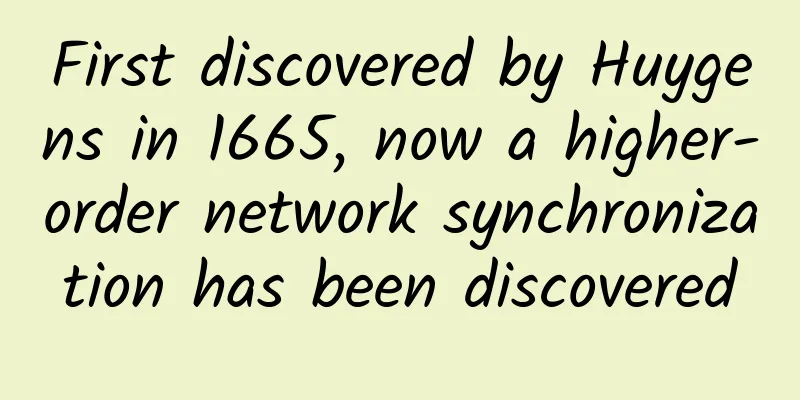First discovered by Huygens in 1665, now a higher-order network synchronization has been discovered

|
A study led by Queen Mary University of London has proposed for the first time a novel 'higher-order' Kuramoto model that combines topology with dynamical systems and characterises synchronization in higher-order networks. Just like an orchestra playing in time without a conductor, elements of a complex system can naturally synchronise with each other. This collective phenomenon, known as synchronization, occurs throughout nature, from neurons firing together in the brain to fireflies flashing in unison in the dark. The Kuramoto model is used to study synchronization observed in complex systems, which are often represented mathematically by networks, where the components in the system are represented as nodes and the links between the nodes represent the interactions between them. Most studies of synchronization have focused on networks, where nodes host dynamical oscillators that behave like clocks and couple to their neighbors along the links of the network. However, the vast majority of complex systems have richer structure than networks and include "higher order" interactions that occur between more than two nodes. These higher-order networks are called simplicial complexes and have been extensively studied by mathematicians in discrete topology. Now, research led by Professor Ginestra Bianconi, Professor of Applied Mathematics at Queen Mary University of London, has proposed a novel "higher-order" Kuramoto model that combines topology with dynamical systems to characterize synchronization in higher-order networks for the first time. The study found that higher-order synchronization occurs suddenly, in an "explosive" way, which is different from the standard Kuramoto model, where synchronization occurs gradually. Mathematician Christian Huygens first discovered synchronization in 1665 when he observed two pendulum clocks suspended from the same wooden beam swinging in time with each other. However, it wasn't until 1974 that Japanese physicist Yoshiki Kuramoto proposed a simple mathematical model to describe this collective phenomenon. Kuramoto's model captures synchronization in a large network in which each node possesses a clock-like oscillator that couples to other oscillators at neighboring nodes. In the absence of links between nodes, each oscillator follows its own dynamics and is not influenced by its neighbors. However, when the interaction between neighboring nodes switches above a given value, the oscillators begin to beat at the same frequency. While the Kuramoto model describes the dynamical synchronization associated with network nodes in a pure complex, higher-order objects in the network (such as links or triangles) can also exhibit dynamical or "topological" signals such as fluxes. In the new study, the researchers proposed a higher-order Kuramoto model that can describe the synchronization of these topological signals. Since topological signals such as flux can be found in the brain and in biological transport networks, the researchers believe that this new model may reveal higher-order synchronization that had not been noticed before. Professor Bianconi, the lead author of the study, said: "The study combines Hodge theory, an important branch of topology, with the theory of dynamical systems to shed light on higher-order synchronization. Using the theoretical framework, it is possible to treat synchronization of topological dynamic signals associated with connections, such as flux, or synchronization with triangles or other higher-order building blocks of higher-order networks. These signals can be synchronized, but this synchronization may be overlooked if the correct topological transformation is not performed." The new study proposes a Fourier transform equivalent to a topological signal that can reveal this. The discontinuous transitions found in the study also show that the synchronization phenomenon is not only spontaneous but also emerges suddenly, revealing how topology causes a drastic change in dynamics at the beginning of the synchronization transition. Boco Park | Research/From: Queen Mary University of London |
<<: This letter from Beijing made Awa Mountain boil!
Recommend
A guide to selecting products and avoiding pitfalls when selling goods through live streaming!
Many small and medium-sized businesses want to se...
The year of social networking: Is WeChat’s status unbreakable?
After QQ and WeChat have dominated the social net...
Where is the future of car-sharing amid the tide of financing?
In February, the car-sharing brand "PonyCar&...
Do you want to slap a mosquito to death? Dinosaurs may have thought so too
Mosquitoes have a way of ruining our mood every s...
"Flying Giant Eye", made in China!
Original title: Planned to be launched this year,...
What’s the best way to shop on Double Eleven? The best money-saving strategy for Double Eleven 2020 is here
I have to say that time flies so fast. There are ...
What health gifts will nutritionists give during the Spring Festival?
Author: Wu Jia (registered dietitian) Editor: Fan...
China Passenger Car Association: China Commercial Vehicle Industry Analysis Monthly Report in April 2021
1. Market Analysis Commercial vehicle market: Dem...
How to get massive traffic through ranking promotion through Baidu Aladdin channel!
The time it takes for SEO to take effect is getti...
Is there a holiday for Children's Day this year? Is it illegal not to have a holiday on Children's Day? Attached is the latest official notification for 2022!
Tomorrow is Children's Day, and on this day ch...
Insomnia, hair loss, and possible extinction... It's really hard to be a giraffe!
This article was first published by Hunzhi (WeCha...
Will headphones that cost 9.9 yuan with free shipping damage your hearing?
Those who pursue cost-effectiveness can often fin...
Year-end review: Major breakthroughs in Chinese science and technology in 2021
2021 is coming to an end. The past year has been ...
New media operation marketing strategy skills!
Through new media operations, we can complete bra...









